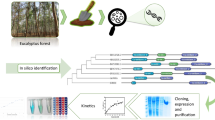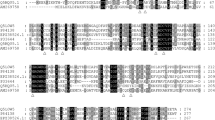Abstract
Laccases have emerged as environment-friendly multifaceted biocatalysts for diverse biotechnological applications. Here, we isolated a high molecular weight (88 kDa) extremophilic laccase (LacT) from Brevibacillus agri, with the aim to exploit its extreme characters in denim bleaching. LacT has been characterized as a thermostable, acidophilic enzyme with high salt, organic solvent, and divalent metal tolerance properties. Denim bleaching efficiency of LacT was optimum at pH 4.0 and appeared to be surpassing over other reported laccases. LacT also exhibited remarkable efficacy in the decolorization of water-soluble health hazardous azo-dyes, and thus transpired to be a promising bio-bleaching and dye decolorizing agent.







Similar content being viewed by others
References
Hsu, C. A., Wen, T. N., Su, Y. C., Jiang, Z. B., Chen, C. W., & Shyur, L. F. (2012). Biological degradation of anthroquinone and azo dyes by a novel laccase from Lentinus sp. Environmental Science & Technolology, 46(9), 5109–5117.
Rai, H. S., Bhattacharyya, M. S., Bansal, T. K., Vats, P., & Banerjee, U. C. (2005). Removal of dyes from the effluent of textile and dyestuff manufacturing industry: a review of emerging techniques with reference to biological treatment. Critical Reviews in Environmental Science and Technology, 35(3), 219–238.
Magdalena, M., Cardenas, I., Rocha-Pena, M. A., Galan-Wong, L. J., Arevalo-Nino, K., & Tovar-Herrera, O. E. (2016). A Pycnoporus sanguineus laccase for denim bleaching and its comparison with an enzymatic commercial formulation. Journal of Environmental Mangement, 177, 93–100.
Taguchi, T., Ebihara, K., Yanagisaki, C., Yoshikawa, J., Horiguchi, H., & Amachi, S. (2018). Decolorization of recalcitrant dyes by a multicopper oxidase produced by Iodidimonas sp. Q-1 with iodide as a novel inorganic natural redox mediator. Scientific Report, 8, 6717.
Fan, H., Yang, J., Gao, T., & Yuan, H. (2012). Removal of a low-molecular basic dye (azure blue) from aqueous solutions by a native biomass of a newly isolated Cladosporium sp.: kinetics, equilibrium and biosorption simulation. Journal of the Taiwan Institute of Chemical Sciences, 43(3), 386–392.
Golka, K., Kopps, S., & Myslak, Z. W. (2004). Carcinogenicity of azo colorants: influence of solubility and bioavailability. Toxicology Letter, 151(1), 203–210.
Schneider, K., Hafner, C., & Jager, I. (2004). Mutagenicity of textile dye products. Journal of Applied Toxicology, 24(2), 83–91.
Husain, Q. (2006). Potential applications of the oxidoreductive enzymes in the decolurization and the detoxification of textile and other synthetic dyes from polluted water: a review. Critical Review of Biotechnology, 26(4), 201–221.
Chhabra, M., Mishra, S., & Sreekrishnan, T. R. (2008). Mediator-assisted decolorization and detoxification of textile dyes/dye mixture by Cyathus bulleri laccase. Applied Biochemistry and Biotechnology, 151(2-3), 587–598.
Robinson, T., McMullan, G., Marchant, R., & Nigam, P. (2001). Remediation of dyes in textile effluent: a critical review on current treatment technologies with a proposed alternative. Bioresoure Technoogy, 77(3), 247–255.
Mate, D. M., & Alcalde, M. (2017). Laccase: a multiprocess biocatalyst at the forefront of biotechnology. Microbial Biotechnology, 10(6), 1457–1467.
Morozova, O. V., Shumakovich, G. P., Gorbacheva, M. A., Shleev, S. V., & Yaropolov, A. I. (2007). “Blue” laccases. Biochemistry (Mosc), 72(10), 1136–1150.
Chauhan, P. S., Goradia, B., & Saxena, A. (2017). Bacterial laccase: recent update on production, properties and industrial applications. 3 Biotech, 7, 323.
Sharma, P., Goel, R., & Capalash, N. (2007). Bacterial laccases. World Journal of Microbiology and Biotechnology, 23(6), 823–832.
Kawai, S., Umezawa, T., Shimada, M., & Higushi, T. (1988). Aromatic ring cleavage of 4,6-di (tert-butyl) guaiacol, a phenolic lignin model compound, by laccase of coriolus versicolor. FEBS Letter, 236(2), 309–311.
Guan, Z. B., Shui, Y., Song, C. M., Zhang, N., Cai, Y. J., & Liao, X. R. (2015). Efficient secretory production of CotA-laccase and its application in the decolorization and detoxification of industrial textile wastewater. Environmental Science and Pollution Research, 22(12), 9515–9523.
Mathews, S. L., Smithson, C. E., & Grunden, A. M. (2016). Purification and characterization of a recombinant laccase-like multi-copper oxidase from Paenibacillus glucanolyticus SLM1. Journal of Applied Microbiology, 121(5), 1335–1345.
Bradford, M. M. (1976). A rapid and sensitive method for the quantitation of microgram quantities of protein utilizing the principle of protein–dye binding. Analytical Biochemistry, 72(1-2), 248–254.
Baltierra-Tejo, E., Marquez-Benavides, L., & Sanchez-Yanez, J. (2015). Inconsistencies and ambiguities in calculating enzyme activity: the case of laccase. Journal of Microbiological Method, 119, 126–131.
Laemmli, U. K. (1970). Cleavage of structural proteins during the assembly of the head of bacteriophage T4. Nature, 227(5259), 680–685.
Neifar, M., Chouchane, H., Mahjoubi, M., Jaouani, A., & Cherif, M. (2016). Pseudomonas extremorientalis BU118: a new salt-tolerant laccase secreting bacterium with biotechnological potential in textile azo dye decolourization. 3. Biotech, 6, 107.
Siroosi, M., Amoozegar, M. A., & Khajeh, K. (2016). Purification and characterization of an alkaline chloride tolerant laccase from a halotolerant bacterium, Bacillus sp. strain WT. Journal of Molecular Catalysis B: Enzymatic, 134, 89–97.
Dalfard, A. B., Khajeh, K., Soudi, M. R., Naderi-Manesh, H., Ranjbar, B., & Sajedi, R. H. (2006). Isolation and biochemical characterization of laccase and tyrosinase activities in a novel melanogenic soil bacterium. Enzyme Microbial Technology, 39(7), 1409–1416.
Sondhi, S., Sharma, P., Saini, S., Puri, N., & Gupta, N. (2014). Purification and characterization of an extracellular, thermos-alkali-stable, metal tolerant laccase from Bacillus tequilensis SN4. PLoS One, 9(5), e96951.
Rezaei, S., Shahverdi, A. R., & Faramarzi, M. A. (2017). Isolation, one-step affinity purification, and characterization of a polyextremotolerant laccase from the halophilic bacterium Aquisalibacillus elongates and its application in the delignification of sugar beet pulp. Bioresource Technology, 230, 67–75.
Margot, J., Bennati-Granier, C., Maillard, J., Blanquez, P., Barry, D. A., & Holliger, C. (2013). Bacterial versus fungal laccase: potential for micropollutant degradation. AMB Express, 3(1), 63.
Baldrian, P. (2006). Fungal laccases—occurrence and properties. FEMS Microbiology Review, 30(2), 215–242.
Galai, S., Limam, F., & Marzouki, M. N. (2009). A new Stenotrophomonas maltophilia strain producing laccase use in decolourization of synthetic dyes. Applied Biochemistry and Biotechnology, 158(2), 416–431.
Palonen, H., Saloheimo, M., Viikari, L., & Kruus, K. (2003). Purification, characterization and sequence analysis of a laccase from the ascomycete Mauginiella sp. Enzyme and Microbial Technology, 33(6), 854–862.
Kumar, R., Kaur, J., Jain, S., & Kumar, A. (2016). Optimization of laccase production from Aspergillus flavus by design of experiment technique: partial purification and characterization. Journal of Genetic Engineering and Biotechnology, 14(1), 125–131.
Schneider, P., Caspersen, M. B., Mondorf, K., Halkier, T., Skov, L. K., Ostergaard, P. R., Brown, K. M., Brown, S. H., & Xu, F. (1999). Characterization of a Coprinus cinereus laccase. Enzyme and Microbial Technology, 25(6), 502–508.
Dong, J. L., & Zhang, Y. Z. (2004). Purification and characterization of two laccase isoenzymes from a ligninolytic fungus Trametes gallica. Preparative Biochemistry and Biotechnology, 34(2), 179–194.
Dedeyan, B., Klonowska, A., Tagger, S., Tron, T., Iacazio, G., Gil, G., & Petit, J. L. (2000). Biochemical and molecular characterization of a laccase from Marasmius quercophilus. Applied and Environmental Microbiology, 66(3), 925–929.
Chen, S., Ge, W., & Buswell, J. A. (2004). Biochemical and molecular characterization of a laccase from the edible straw mushroom, Volvariella volvacea. European Journal of Biochemistry, 271(2), 318–328.
Johannes, C., & Majcherczyk, A. (2000). Laccase activity tests and laccase inhibitors. Journal of Biotechnology, 78(2), 193–199.
Chakroun, H., Mechichi, T., Martinez, M. J., Dhouib, A., & Sayadi, S. (2010). Purification and characterization of a novel laccase from the ascomycete Trichoderma atroviride: application on bioremediation of phenolic compounds. Process Biochemistry, 45(4), 507–513.
Wu, M. H., Lin, M. C., Lee, C. C., Yu, S. M., Wang, A. H. J., & Ho, T. H. D. (2009). Enhancement of laccase activity by pre-incubation with organic solvents. Scientific Reports, 9, 9754.
Sinha, R., & Khare, S. K. (2014). Effect of organic solvents on the structure and activity of moderately halophilic Bacillus sp. EMB9 protease. Extremophiles, 18(6), 1057–1066.
Rahman, R. N. Z. R. A., Salleh, A. B., Basri, N., & Wong, C. F. (2011). Role of α-helical structure in organic solvent-activated homodimer of elastase strain K. International Journal of Molecular Science, 12(9), 5797–5814.
Nagai, M., Sato, T., Watanabe, H., Saito, K., Kawata, M., & Enei, H. (2002). Purification and characterization of an extracellular laccase from the edible mushroom Lentinula edodes, and decolorization of chemically different dyes. Applied Microbiology and Biotechnology, 60, 327–235.
Srivastava, S., Sinha, R., & Roy, D. (2004). Toxicological effects of malachite green. Aquatic Toxicology, 66(3), 319–329.
Zhang, C., Zhang, S., Diao, H., Zhao, H., Zhu, X., Lu, F., & Lu, Z. (2013). Purification and characterization of a temperature and pH-stable laccase from the spores of Bacillus vallismortis fmb-103 and its application in the degradation of malachite green. Journal of Agricultural and Food Chemistry, 61(23), 5468–5473.
Yang, J., Yang, X., Lin, Y., Ng, T. B., Lin, J., & Ye, X. (2015). Laccase-catalyzed decolourization of malachite green: performance optimization and degradation mechanism. PLoS One, 10(5), e0127714.
Zille, A., Tzanov, T., Gubitz, G. M., & Cavaco-Paulo, A. (2003). Immobilized laccase for decolourization of Reactive Black 5 dying effluent. Biotechnology Letters, 25(17), 1473–1477.
Zhang, J., Sun, L., Zhang, H., Wang, S., Zhang, X., & Geng, A. (2018). A novel homodimer laccase from Cerrena unicolor BBP6: purification, characterization, and potential in dye decolorization and denim bleaching. PLoS One, 13(8), e0202440.
Acknowledgments
We acknowledge the Council of Scientific and Industrial Research, Government of India for funding the research grant (No. 37(1728)/19/EMR-II) to T.D. V.P. acknowledges the University Grants Commission (UGC), Government of India, for the fellowship (UGC reference no. 3501/(NET-JULY 2016)).
Author information
Authors and Affiliations
Contributions
T.D., J.N.S., and V.P. designed the experiments. V.P. performed the experiments and T.D. wrote the paper.
Corresponding author
Ethics declarations
Conflict of Interest
The authors declare that they have no competing interests.
Additional information
Publisher’s Note
Springer Nature remains neutral with regard to jurisdictional claims in published maps and institutional affiliations.
Rights and permissions
About this article
Cite this article
Panwar, V., Sheikh, J.N. & Dutta, T. Sustainable Denim Bleaching by a Novel Thermostable Bacterial Laccase. Appl Biochem Biotechnol 192, 1238–1254 (2020). https://doi.org/10.1007/s12010-020-03390-y
Received:
Accepted:
Published:
Issue Date:
DOI: https://doi.org/10.1007/s12010-020-03390-y




